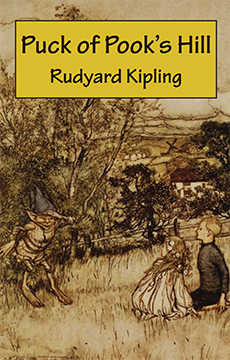
Puck of Pook's Hillby Rudyard Kipling
Illustrated by Claude Allen Shepperson
Buy or preview the book on amazon.comOutside the US, search for this
|
A Heritage Facsimile Edition
This is the only edition of this book that reproduces the stories as they appeared in the Strand magazine, allowing today’s reader to experience these stories in the same way their earliest readers did.
As this fantasy book begins, two children have finished performing bits of Shakespeare’s “Midsummer’ Night’s Dream” and meet Puck on Pook’s Hill, which was originally named Puck’s Hill.
Puck tells the children he is “the oldest Old Thing in England,” and he entertains them with stories about English history, which he magically plucks characters out of history to tell. The stories range from Roman times to the fifteenth century.
The combination of history and fantasy has made this book a beloved favorite of both children and adults since it was first published in 1906.
Rudyard Kipling was a poet, short story writer, and novelist. He was born in Bombay, educated in England, and lived in both India and England as an adult. His best-known works for children include The Jungle Book, Kim and Just So Stories as well as Puck of Pook’s Hill. His best known poems include “Gunga Din,” “The Road to Mandalay,” and “If.”
In 1907, he won the Nobel Prize in Literature, the first writer in the English language to receive the prize.
In addition to facsimiles of the stories as they were published in The Strand, with illustrations by Claude Allen Shepperson, this edition contains poems that Kipling added when Puck of Pook’s Hill was published in book form.
About this Series
Heritage Facsimile Editions are reproductions of classic works of literature as they first appeared in illustrated magazines.
In the days before electronic media, illustrated magazines were one of the most common forms of popular entertainment, filled with stories and serialized novels. The illustrations were a key part of the reader’s experience.
There was a delay before these stories and novels were published in book form, to give people an incentive to subscribe to the magazines. The books kept down costs by omitting the illustrations. This series publishes the books using facsimiles of the magazine articles, including the original illustrations.


